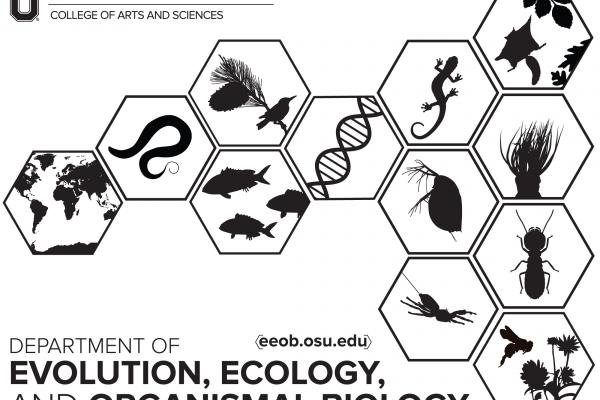April 25, 2019
Publications by EEOB Faculty April 1 - April 30

Genome and Ontogenetic-Based Transcriptomic Analyses of the Flesh Fly, Sarcophaga bullata
Ellen O. Martinson, Justin Peyton, Yogeshwar D. Kelkar, Emily C. Jennings, Joshua B. Benoit, John H. Werren and David L. Denlinger. 2019. G3: GENES, GENOMES, GENETICS. https://doi.org/10.1534/g3.119.400148
Abstract
The flesh fly, Sarcophaga bullata, is a widely-used model for examining the physiology of insect diapause, development, stress tolerance, neurobiology, and host-parasitoid interactions. Flies in this taxon are implicated in myiasis (larval infection of vertebrates) and feed on carrion, aspects that are important in forensic studies. Here we present the genome of S. bullata, along with developmental- and reproduction-based RNA-Seq analyses. We predict 15,768 protein coding genes, identify orthology in relation to closely related flies, and establish sex and developmental-specific gene sets based on our RNA-Seq analyses. Genomic sequences, predicted genes, and sequencing data sets have been deposited at the National Center for Biotechnology Information. Our results provide groundwork for genomic studies that will expand the flesh fly's utility as a model system.
Effects of soil properties on the toxicity and bioaccumulation of lead in soil invertebrates
Roman P Lanno, Koen Oorts, Erik Smolders, Katie Albanese, M Jasim Chowdhury. 2019. Environmental Toxicology and Chemistry. https://doi.org/10.1002/etc.4433
Abstract
The present study examined the effects of soil physical and chemical properties on the toxicity of lead (Pb) to earthworms (Eisenia fetida) and collembolans (Folsomia candida), and on bioaccumulation of Pb by earthworms, in soils amended with Pb salts. Toxicity tests were conducted in seven soils varying in soil properties (pH: 4.7‐7.4, eCEC: 4‐42 cmolc/kg, organic carbon: 10 – 50 g C/kg) that were leached and pH corrected after spiking with PbCl2. EC50s based upon total soil Pb concentrations ranged from 35 to 5080 mg Pb/kg for earthworms and 389 to >7190 mg/kg for Collembola. Significant positive correlations were observed between log (EC50) for earthworm reproduction and log (eCEC, total C, exchangeable Ca and Mg, or clay content), but no significant correlations were observed between Pb toxicity to Collembola and soil properties. Expressing Pb dose as either the free ion (Pb2+) activity in pore water or as the measured dissolved porewater concentration of Pb did not explain differences in toxicity among soils. The bioaccumulation factors (BAFs) for Pb in earthworms ranged more than 10‐fold across six soil treatments, with a median of 0.16, and the BAF was significantly correlated with eCEC (p = 0.038, r = ‐0.84), but not with any other soil properties. Soil properties related to cation‐exchange capacity (eCEC, total C, exchangeable Ca and Mg, clay content) had a significant effect on Pb toxicity and bioaccumulation in earthworms, but no relationship was found for Collembola. CEC is a major soil property affecting the bioavailability of Pb and should be incorporated into any soil hazard assessment of Pb as a modifying factor of toxicity and bioaccumulation for earthworms.
Tick development on sexually-active bull moose is more advanced compared to that of cow moose in the winter tick, Dermacentor albipictus
Jay A. Yoder, Peter J. Pekins, Cameron J. Dobrotka, Kelli A. Fisher, Lee Kantar, Scott McLellan, Matt O'Neal, and Hans Klompen. 2019. Int J Parasitol Parasites Wildl. 9: 56–59. doi: 10.1016/j.ijppaw.2019.03.006
Abstract
We performed a complete survey of ticks on 100 cm2 skin samples collected from 30 moose (Alces alces) harvested in 2017 in central and northern Maine, U.S.A. The samples were collected from 15 bulls, 13 cows, and 2 calves in mid-October when moose are breeding and winter ticks (Dermacentor albipictus) quest for a host. We identified only winter ticks with 99.2% in a juvenile stage; 3 adult ticks were found. Unfed nymphs were most common on bulls, whereas most ticks were fed larvae on cows and calves. The mean total count on bull samples was 21 ± 4.4 (range = 0–55) and higher than on cows (6 ± 0.5; range = 2–8). Unlike previous surveys, tick abundance was lowest on calves. Tick abundance was independent of age or weight of adult moose. The higher abundance and more rapid development of winter ticks on adult bulls likely reflects the seasonal influence of increased movements and hormonal cycles associated with reproduction.
Characterization of drought-induced rapid cold-hardening in the Antarctic midge, Belgica antarctica
Yuta Kawarasaki, Nicholas M. Teets, Benjamin N. Philip, Leslie J. Potts, J. D. Gantz, David L. Denlinger, Richard E. Lee, Jr. 2019.
Polar Biol. https://doi.org/10.1007/s00300-019-02503-6
Abstract
Survival of the terrestrial midge, Belgica antarctica, on the Antarctic Peninsula is promoted, not only by their adaptations to prolonged exposures to seasonal stresses, but also by their ability to respond to unpredictable changes in their environments. Rapid cold-hardening (RCH) is an extremely swift acclimatory response of insects that occurs within minutes to hours. While the RCH response is most commonly induced by a brief exposure to mildly low temperatures, a similar rapid acclimatory response can also be elicited by exposure to drought. In this study, we characterized this drought-induced RCH in larvae of B. antarctica. Compared to fully hydrated larvae, those desiccated at various relative humidity (R.H.) conditions between 0 and 99% R.H. for 2 h had a significantly greater survival ( ~ 50%) to freezing at − 14 °C. The amount of water loss varied between 4 and 16% depending on R.H. conditions; however, all treatments were equally effective in eliciting the protective response against freezing stress, and its induction was evident within 30 min of desiccation. Lack of substantial changes in body-fluid osmolality or levels of major cryoprotectants suggest that accumulation of these protective solutes is not a primary mechanism of this response. Interestingly, the RCH protection induced by desiccation persisted after larvae were allowed to recover a significant portion of the lost water. Our results indicate that larval midges are highly sensitive to desiccation, capable of swiftly initiating physiological changes in response to a small reduction in their body water content.
